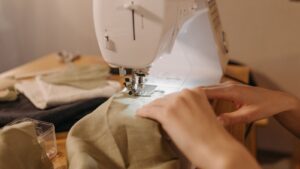Dive into the world of creativity with home sewing projects! Whether you’re a seasoned seamstress or a novice with a needle, there’s something incredibly satisfying about creating your own piece of art from scratch. From bespoke clothing to unique home décor, the possibilities are endless.
Understanding the Basics of Home Sewing Projects
A sewing machine, the heart of any home sewing project, must suit the user’s skills and requirements. For beginners, a basic machine suffices, outfitted with a straight stitch, zigzag stitch, and a buttonhole feature. Upgraded models boasting advanced features, such as built-in stitches and touchscreen controls, serve experienced seamstresses better.
Stitches transform mere fabric into functional, attractive items. Familiarity with a few key stitches propels one’s sewing success. The straight stitch, for instance, forms the backbone of sewing projects, securing fabric pieces together. The zigzag stitch, on the other hand, prevents fraying edges, thereby enhancing the project’s longevity. Additionally, stretch stitches accommodate materials with elasticity – such as knit fabrics – without causing unwelcome puckering or distortion.

Novices master the basics initially, subsequently delving into more complex stitches. With practice, they’ll tackle decorative, blind hem, and overcasting stitches effortlessly.
Tips:
- Adjust the stitch length and width to manipulate its appearance and function.
- Regularly clean and oil the machine, as maintenance ensures smooth stitch formation.
- Test stitches on fabric scraps to reduce errors on actual projects.
Understanding the essentials facilitates the remarkable transformation of ordinary materials into extraordinary creations through home sewing projects.
Home Sewing Projects
Transforming plain fabric into attractive custom pillowcases presents an accessible introduction to home sewing projects for beginners. This endeavor does more than just showcasing one’s creativity. It improves basic sewing skills such as cutting fabric to desired dimensions and sewing neatly in a straight line.

Creating a custom pillowcase only requires three entities: the fabric for the pillowcase, thread matching the fabric color, and a sewing machine. Below are the steps to prepare one:
- Measure: Start with the necessary measurements – the length and breadth of the preferred-sized pillow. Add an extra inch for seam allowance on all sides.
- Cut: Cut out the fabric according to the measured dimensions.
- Stitch: After folding the fabric right sides together, stitch down the longer sides leaving an opening on one end.
- Finish: Use an overcast or zigzag stitch for finishing the seams, avoiding unravelling.
Such a home sewing project not only adds a personal touch to one’s decor but also enhances basic sewing skills.
Essential Tools for Home Sewing Projects
Initiating a comprehensive rundown on essential tools and equipment, this part of the article delineates necessary items for successful home sewing projects. The article also provides practical advice on organizing your sewing space efficiently, enhancing productivity.
Must-Have Sewing Tools and Equipment

In the realm of home sewing projects, crafting unique items requires an array of specific tools and equipment.
- Sewing Machine: The heart of any sewing undertaking, a quality sewing machine, apt for your skill level, boosts efficiency and outcome.
- Dressmaker’s Shears: These specialized scissors facilitate precise fabric cutting, essential for accurate construction of sewing projects.
- Pins and Pincushion: Pins secure fabric pieces together during sewing, with a pincushion facilitating safe, handy storage.
- Seam Ripper: Involved in rectifying sewing errors, a seam ripper helps in removing stitches without damaging fabric.
- Measuring tools: A flexible measuring tape and a ruler render vital assistance while taking measurements. A seam gauge also provides help in maintaining regular seam allowances.
- Marking Tools: Chalk or fabric markers provide visual cues on fabric, assisting in accurate cutting or stitching.
- Iron and Ironing Board: These crucial tools ensure crease-free fabrics during sewing, enhancing the final product’s look.
- Thread assortment: A collection of threads in various colors allows for matching with different fabrics. Quality threads improve the strength and durability of seams.
- Needles: Both machine and hand sewing needles, in assorted sizes, play key roles. They pierce through fabric, creating stitches.
Remember, organized sewing spaces boost productivity, saving time and effort while engaging in home sewing projects. An orderly space also helps maintain focus, turning your creative ideas into stunning creations.

